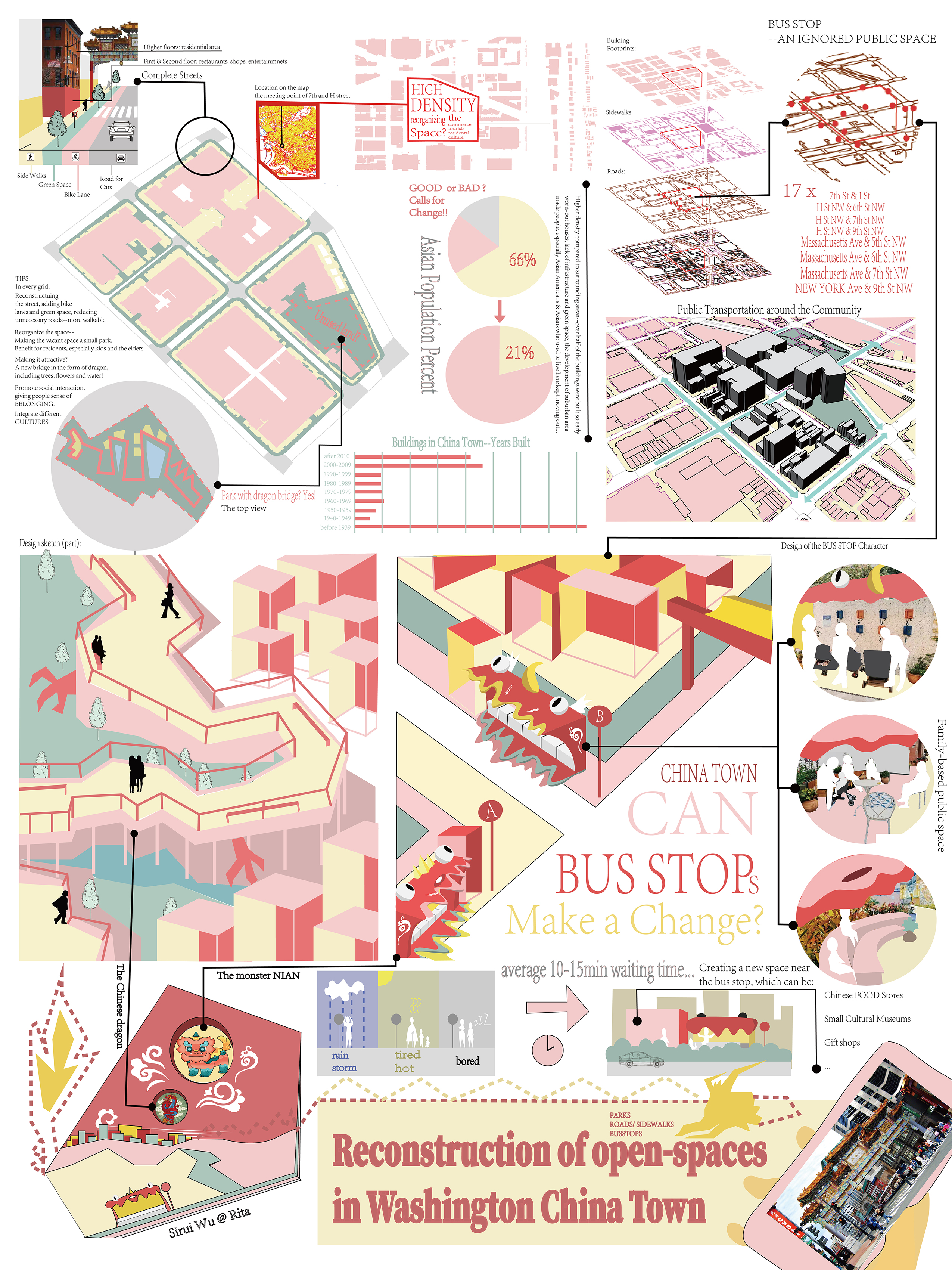Cultural Amplifier
Reconstruction of Open- Spaces in Washington, DC China Town
Proposal by Rita WuRunner-up
As an international student who came to the United States for the first time, I realized it is really a challenge to find a balance between fitting into the new environment and keeping my own cultural identity, whether at school or in daily life. In the small town I am now living in, it is hard to find architectures that contain strong cultural elements. So, it keeps me wondering about how can make the environment more inclusive, how can we reflect our culture in a direct and narrative way, rather than just the symbolic ideology.
I find it interesting when I first get to know that the
competition topic is choosing a detailed place in Washington DC because I have
never been there before. But on the other hand, I represent the perspective of
those who do not live there but still hope to see their typical cultural site
in a large city, especially when it is the capital. In this way, I choose China
Town as the place I am aiming at. No matter how time changes, the China town is
no doubt the first place that people (especially visitors and local non-Asian
groups) can think of when mentioned Chinese culture.
It was also sad to see that the vitality of the whole China Town community is gradually declining due to many reasons, including public security problems, the move of local restaurants to the suburban areas, and the weakening of “the sense of belonging” of the second-generation immigrants. It is a place that needs to be improved and better planned. At first, I thought of changing it to a commercial area that can attract more tourists just like South-Luogu street in Beijing. But after carefully analyzing the distribution of residential places and traffic in this area, I find it is hard to be done without interrupting the lives of current residents and rebuilding the houses, which is not so efficient and beyond my ability. Therefore, I just focus on some changes in detail that can enhance the living and visiting experience.
![]()
Back to Cultural Amplifier
It was also sad to see that the vitality of the whole China Town community is gradually declining due to many reasons, including public security problems, the move of local restaurants to the suburban areas, and the weakening of “the sense of belonging” of the second-generation immigrants. It is a place that needs to be improved and better planned. At first, I thought of changing it to a commercial area that can attract more tourists just like South-Luogu street in Beijing. But after carefully analyzing the distribution of residential places and traffic in this area, I find it is hard to be done without interrupting the lives of current residents and rebuilding the houses, which is not so efficient and beyond my ability. Therefore, I just focus on some changes in detail that can enhance the living and visiting experience.

- Make some improvements on the streets in the China
Town area, making it a “complete street” with green space, bike lane, and open
public space for more street activities. Especially during this COVID time, it
is a much better choice to encourage outside interaction than inside the
buildings. Meanwhile, street activity means that more people can pay attention
to the development of this area and reduce street crime to some extent.
-
There are about 14+ bus stops near this area,
but most of them are poorly constructed. I am thinking of why not change it to
unique elements just like the front gate of China Town. As bus stops can also
be considered as an ignored public space, they also have the function of
improving social communication and showing knowledge of the Chinese culture. By
giving bus stops an entirely new appearance (the shape of Nian and lions) along
with the tiny museums, food stores, or Chinese gifts shops near it, it can be a
new fashion trend that attracts young people and make the waiting time more fun
and comfortable. It can also cooperate with local media/internet media like
blogs or apps, which have a positive effect on the economy.
-
By viewing the plant of the community, I found
there to be a medium-sized vacant lot inside. I decided to make it a mini-park
with trees, water, and most important—a bridge in the shape of a dragon. The
reason that I chose dragon is that it is a typical character and easy to
intimate. This action can add to the social infrastructure and green space
around the community, which can be a benefit for both the residents and the
visitors.
Back to Cultural Amplifier
